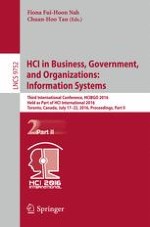2016 | Book
HCI in Business, Government, and Organizations: Information Systems
Third International Conference, HCIBGO 2016, Held as Part of HCI International 2016, Toronto, Canada, July 17-22, 2016, Proceedings, Part II
Editors: Fiona Fui-Hoon Nah, Chuan-Hoo Tan
Publisher: Springer International Publishing
Book Series : Lecture Notes in Computer Science
